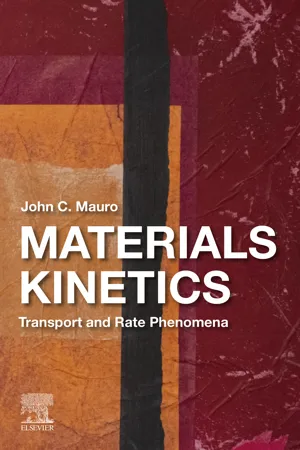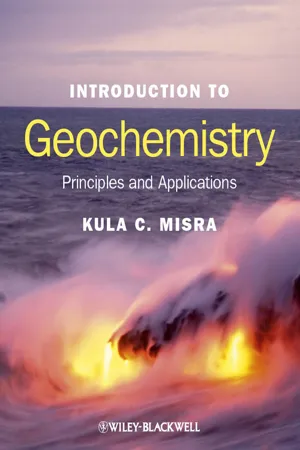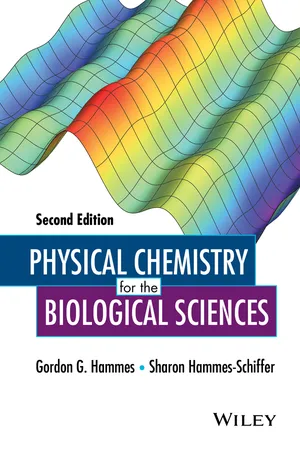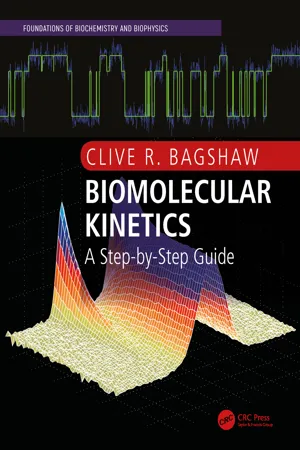Physics
Thermodynamic and Kinetic Control
Thermodynamic control refers to the outcome of a reaction being determined by the stability of the products, while kinetic control involves the influence of reaction rates on the outcome. In a thermodynamically controlled process, the most stable product is favored, whereas in a kinetically controlled process, the product formed is determined by the rate of the reaction. These concepts are fundamental in understanding chemical and physical processes.
Written by Perlego with AI-assistance
Related key terms
7 Key excerpts on "Thermodynamic and Kinetic Control"
- eBook - ePub
Electrochemical Energy Storage
Physics and Chemistry of Batteries
- Reinhart Job(Author)
- 2020(Publication Date)
- De Gruyter(Publisher)
2 ThermodynamicsThermodynamics is a fundamental part of classical physics. It is a closed theory describing macroscopic physical properties – such as the internal energy, entropy, pressure and volume – of matter (and radiation). Thermodynamics shows that the physical properties of matter are subject to general constraints that are common to all substances and materials; anyhow, the appearances of particular properties of specific substances and materials are different. The fundamental constraints are expressed in the thermodynamic laws. These laws completely rule our macroscopic world; and they are described further briefly in this chapter.Thermodynamics is the base of a large variety of topics in science and engineering. It is fundamental for mechanical and chemical engineering. In particular, it describes physical and chemical equilibrium states, and therefore, it is very important for chemistry and chemical reactions. With the help of experimentally measured thermal data, energetic changes of matter and systems can be calculated, and hence, a change of equilibrium states or phase transitions can be predicted and simulated. The same holds for the chemical reactions and processes. Altogether, thermodynamics has a very strong practical relevance in chemistry and engineering.Before we discuss the fundamental four laws of thermodynamics, in the following subsection, we introduce a variety of physical terms and definitions, which are necessary for the later explanations.2.1 Terms and definitions
Dealing with thermodynamics requires a set of definitions and a good understanding of the physical terms and wordings, which has to be clarified before further explanations and discussions are presented.2.1.1 Systems
A system is a macroscopically spatially well-defined part of the universe. It is the special part of the universe that is to be studied or analyzed, and it is separated from the surroundings (Figure 2.1 - eBook - ePub
Fluid and Thermal Dynamics Answer Bank for Engineers
The Concise Guide with Formulas and Principles for Students and Professionals
- Ethirajan Rathakrishnan(Author)
- 2023(Publication Date)
- BrownWalker Press(Publisher)
Chapter 8
Thermodynamics
8.1Basic Concepts and Definitions
Thermodynamics may be defined as the study of energy, its forms and transformations, and the interaction of energy with matter. Thermodynamics deals with the conservation of energy from one form to another.The first law of thermodynamics is an expression of the energy conservation principle. The second law of thermodynamics asserts that spontaneous processes occur only in a particular direction and never in a direction opposite to that. Further, it ascertains that energy has quality as well as quantity .A macroscopic approach to the study of thermodynamics which does not require a knowledge of the behaviour of the individual particles of the substance is called classical thermodynamics . An elaborate approach, based on the behaviour of individual particles is called statistical thermodynamics .A closed system or control mass is a fixed amount of mass, and no mass can cross its boundaries but energy can cross its boundaries. An open system or control volume is a properly chosen region in space. Both mass and energy can cross the boundary of a control volume but the shape of the control volume will remain unchanged.The sum of all forms of energy of a system is called its total energy E . The total energy of a system is made up of microscopic energy group and macroscopic energy group . The internal energy is the sum of all the microscopic forms of energy.The portion of the internal energy of a system, associated with the kinetic energy of the molecules is called the sensible energy . The internal energy associated with the phase of a system is called the latent energy . The internal energy associated with the bonds in a molecule is called the chemical or bond energy - eBook - ePub
Materials Kinetics
Transport and Rate Phenomena
- John C. Mauro(Author)
- 2020(Publication Date)
- Elsevier(Publisher)
Chapter 1: Thermodynamics vs. Kinetics
Abstract
Thermodynamics concerns the relative stability of the various states of a system, whereas kinetics concerns the approach to equilibrium and the intermediate states visited along the way. Thermodynamic processes are spontaneous if they result in a decrease in the Gibbs free energy of the system. The change in Gibbs free energy has both enthalpic and entropic contributions. However, the spontaneity of a process says nothing about the rate of its kinetics. As proposed by Boltzmann, entropy is a measure of the number of microstates visited by a system to produce a specific macrostate. Justification of both the second and third laws of thermodynamics can be made in terms of the underlying statistical mechanics of the system and Boltzmann's equation for entropy.Keywords
Thermodynamics; Kinetics; Free Energy; Enthalpy; Entropy; Statistical Mechanics1.1. What is Equilibrium?
The field of classical thermodynamics is primarily concerned with equilibrium states, i.e., the states to which systems will eventually evolve and become stable. Although the concept of equilibrium is seemingly intuitive, this simplicity can be deceptive. Perhaps the most insightful definition of equilibrium is given by Richard Feynman [1 ], who said that equilibrium is “when all the fast things have happened but the slow things have not.”“Surely you're joking, Mr. Feynman!” we may be tempted to reply. While Feynman's definition may seem somewhat flippant at first, it incisively captures the importance of time scale in determining what constitutes equilibrium.Perhaps we should rephrase our response to Mr. Feynman. If equilibrium is “when all the fast things have happened but the slow things have not,” this begs the questions, “What is fast?” and “What is slow?” Indeed, “fast” and “slow” are intrinsically relative terms and depend on your perspective as an observer [2 - eBook - ePub
Introduction to Geochemistry
Principles and Applications
- Kula C. Misra(Author)
- 2012(Publication Date)
- Wiley-Blackwell(Publisher)
4 Basic Thermodynamic ConceptsThermodynamics, like other sciences, has a theoretical side, expressed in mathematical language, and a practical side, in which experiments are performed to produce physical data required and interpreted by the theoretical side. The mathematical side of ther modynamics is simple and elegant and is easily derived from first principles. The difficulty in understanding and using thermodynamics is conceptual, not mathematical.Anderson and Crerar (1993)Thermodynamics is the science that deals with differences in and possible transfers of energy, and in some cases of matter, among systems. It is an integral part of geochemistry because it provides a universally applicable framework for characterizing chemical reactions that ultimately control the distribution of elements and minerals in the Earth. The beauty of classical thermodynamics lies in the fact that it is based on two empirical laws (and a few consistent conventions) that are adequate to quantitatively relate a host of macroscopic measurements such as temperature, pressure, volume, etc., without requiring knowledge of the underlying molecular structure of the materials involved in chemical reactions. Statistical thermodynamics (or statistical mechanics ), on the other hand, is the science that relates the properties of individual molecules and their interactions to the empirical results of classical thermodynamics. The laws of classical and quantum mechanics are applied to molecules; then, by suitable statistical averaging methods, the rules of macroscopic behavior that would be expected from an assembly of a large number of molecules are formulated (Klotz and Rosenberg, 1994, p. 5).A limitation of thermodynamics is that it does not provide any information about the rate or mechanism of a thermodynamically predicted chemical reaction. Some reactions, especially at low temperatures, are so sluggish that, for all practical purposes, they do not seem to proceed at all. If this were not the case, we would have no igneous or metamorphic rocks surviving on the Earth’s surface. The study of the rates and mechanisms (pathways) of reactions belong to the field of kinetics - eBook - ePub
- Gordon G. Hammes, Sharon Hammes-Schiffer(Authors)
- 2015(Publication Date)
- Wiley(Publisher)
CHEMICAL KINETICSPassage contains an image
Chapter 5 Principles of Chemical Kinetics
5.1 INTRODUCTION
Thermodynamics tells us what changes in state can occur, that is, the relative stability of states. For chemical reactions, it tells us what reactions can occur spontaneously. However, thermodynamics does not tell us the time scale for changes in state or how the changes in state occur; it is concerned only with the differences in the initial and final states. In terms of chemical reactions, it does not tell us how the reaction occurs, in other words, the molecular interactions that take place as a reaction occurs. For biological reactions, the rates are critical for the survival of the organism, and a primary interest of modern biology is the molecular events that lead to reaction. The study of the rates and mechanisms of chemical reactions is the domain of chemical kinetics. Thermodynamics provides no intrinsic information about mechanisms.Many examples exist with regard to the importance of the time scale for chemical reactions. For those of you having diamond jewelry, you may be unhappy to know that the most stable state of carbon under standard conditions is graphite. So as you read this, your diamond is turning to graphite, but fortunately the time scale for this conversion is many hundreds of years. If graphite is more stable, why were diamonds formed? The answer is that the formation of diamonds did not occur under standard conditions: it is well known that at very high temperatures and pressures, graphite can be converted to diamond. In the biological realm, one of the most critical reactions is the hydrolysis of ATP to ADP and Pi . Thermodynamics tells us that the equilibrium lies far toward ADP and Pi - eBook - ePub
- Tangellapalli Srinivas, N. Shankar Ganesh, R. Shankar(Authors)
- 2019(Publication Date)
- Apple Academic Press(Publisher)
Classical thermodynamics or macroscopic thermodynamics uses the measurable properties such as pressure, volume, temperature, etc. The statistical thermodynamics or microscopic thermodynamics studies the individual molecules. The macroscopic study is focused on few coordinates which are readily available to study the system. The microscopic study describes complete coordinates of velocity (u, v, and w), momentum and position (x, y, and z). The probability is the key study is statistical thermodynamics. It deals the system structures and time average behavior. 3.3 THERMODYNAMIC SYSTEM In thermodynamics, the subject to be focused is called thermodynamic system. Thermodynamic system is a prescribed region with finite matter upon which attention is given for study. To understand the concept of system, Figure 3.1 shows the schematic material flow diagram of a typical thermal power plant operated by coal feed. It consists of four thermodynamic systems, namely, pump, boiler, turbine, and condenser. The feedwater is heated with hot flue gas and converted into superheated steam. In the condenser, the expanded steam is condensed by circulating water in the heat exchanger. The systems are handling various fluids such as steam, circulating water, feedwater, and hot gas. Similarly, the systems also involve heat and work transfers. Therefore, thermodynamic system can be described with mass and energy transactions. FIGURE 3.1 Thermal power plants with subsystems of turbine, condenser, pump, and boiler To understand the nature of system, it is required to define the terminology used in system and they are surroundings, boundary, control surface, control volume, etc. Surroundings are everything external to the system also called environment. Boundary is the enclosure that separates the system from the surroundings. The boundary is be existed or imagined for the convenience. It may be fixed or moving. Combined total system and surroundings is called the universe - eBook - ePub
Biomolecular Kinetics
A Step-by-Step Guide
- Clive R. Bagshaw(Author)
- 2017(Publication Date)
- CRC Press(Publisher)
70 ].First and foremost, thermodynamics provides an essential accounting method to check that kinetic schemes are internally consistent and to ensure that a proposed mechanism does not correspond to a perpetual motion device. Thermodynamics, as such, has nothing to say about the rate of a reaction, but it does indicate whether a reaction is able to proceed in a net forward or reverse direction. Nevertheless, thermodynamic concepts are implicated in theories of absolute reaction rates (Section 3.4 ). Thermodynamics also provides the tools to quantitatively describe the interconversion between different forms of energy. Chemical energy is the most relevant form for most biochemical reactions, but other forms need consideration, for example, mechanical energy in the action of motor proteins, electrical energy in ion transport, and redox reactions or photon energy in light-driven and -emitting reactions. Energy is the capacity to do work and work is formally defined as the operation of a force, F , through a distance, x . Work, w , is not a form of energy but a mechanism of its transfer that achieves or utilizes uniform motion in the surroundings (e.g., lifting a weight or stretching a spring). This contrasts with heat, q , which achieves or utilizes random motions in the surroundings [71 ]. The total energy of a system, U, is difficult to quantify, but that which is transferred, ΔU, can be defined asΔ U = w + q3.13.1Heat can be utilized to generate work using a heat engine, but this requires a heat source and heat sink to be at different temperatures, as in the Carnot cycle. Biological systems usually operate at constant temperature, and so the Carnot cycle has no direct relevance [72 ]. In living systems, energy released as heat is generally dissipated to the surroundings and lost forever. This limits the efficiency of energy transduction. In addition, biological systems generally operate at constant pressure, P, and therefore show changes in volume, ΔV , during a chemical reaction. Such expansion or contraction must be allowed for in energy balance calculations. It is for this reason that we deal with enthalpy, ΔH , rather than ΔU in our accounting exercise, because ΔH allows for the PΔV
Index pages curate the most relevant extracts from our library of academic textbooks. They’ve been created using an in-house natural language model (NLM), each adding context and meaning to key research topics.






